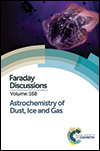Wavelength resolved UV photodesorption and photochemistry of CO2 ice
Abstract
Over the last four years we have illustrated the potential of a novel wavelength-dependent approach in determining molecular processes at work in the photodesorption of interstellar ice analogs. This method, utilizing the unique beam characteristics of the vacuum UV beamline DESIRS at the French synchrotron facility SOLEIL, has revealed an efficient indirect desorption mechanism that scales with the electronic excitations in molecular solids. This process, known as DIET – desorption induced by electronic transition – occurs efficiently in ices composed of very volatile species (CO, N2), for which photochemical processes can be neglected. In the present study, we investigate the photodesorption energy dependence of pure and pre-irradiated CO2 ices at 10–40 K and between 7 and 14 eV. The photodesorption from pure CO2 is limited to photon energies above 10.5 eV and is clearly initiated by CO2 excitation and by the contribution of dissociative and recombination channels. The photodesorption from “pre-irradiated” ices is shown to present an efficient additional desorption pathway below 10 eV, dominating the desorption depending on the UV-processing history of the ice film. This effect is identified as an indirect DIET process mediated by photoproduced CO, observed for the first time in the case of less volatile species. The results presented here pinpoint the importance of the interconnection between photodesorption and photochemical processes in interstellar ices driven by UV photons having different energies.
- This article is part of the themed collection: Astrochemistry of Dust, Ice and Gas

 Please wait while we load your content...
Please wait while we load your content...